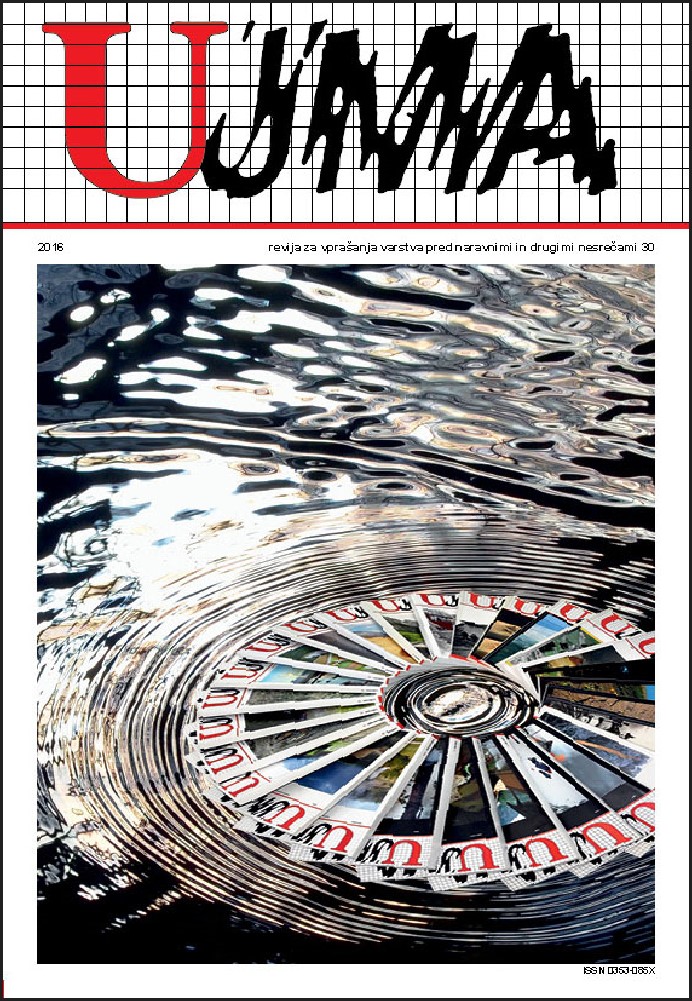OIL SPILL STRANDING PROCESSES AT THE SEA SHORE
Abstract
The article addresses the processes of oil deposition on the shore and oil release from the shore in the event of an oil spill at sea. We selected two characteristic sections of sandy and gravel shores on the Slovenian coast. For both we calculated the maximum oil-holding capacity using an empiric equation based on measurements. This approach enables calculation with data which are usually at hand and simple integration of the equation in the numerical models of the oil spill dispersion. For the two selected sections, we have also calculated the release of oil from the shore assuming that the maximum oil-holding capacity is reached. It has been established that oil release from a sandy shore ceases after a few days, while this process is up to three or four orders of magnitude longer on a gravel shore. The knowledge of the shore's oil-holding capacity, the quantity of the subsequently released oil and the duration of the release for different oil and shore types can contribute to a sound response of the appropriate services being in charge for protection of the shore sections from which the oil is released or those that the released oil might reach.
References
Bosnič, M., 2014. Ranljivost slovenske obale za onesnaženje z nafto. Diplomska naloga. Ljubljana, Univerza v Ljubljani, Fakulteta za gradbeništvo in geodezijo (samozaložba M. Bosnič).
Cheng, N. S., Law, A. W. K., Findikakis, A. N., 2000. Oil transport in the surf zone. Journal of Hydraulic Engineering 126, 11: 803–809.
Etkin, D. S., French-McCay, D., Michel, J., 2007. Review of the State-Of-The-Art on Modeling Interactions between Spilled Oil and Shorelines for the Development of Algorithms for Oil Spill Risk Analysis Modeling. MMS OCS Study 2007-063. New York, Cortlandt Manor, Environmental Research Consulting, MMS Contract 0106PO39962.
Fingas, M., 2011. Oil spill science and technology: prevention, response, and clean up. Burlington, Elsevier.
Gartner, M., 2014. Analiza valovne klime in ocena projektne višine vala za Tržaški zaliv. Diplomska naloga. Ljubljana, Univerza v Ljubljani, Fakulteta za gradbeništvo in geodezijo (samozaložba Garner, M.).
Gundlach, E. R., 1987. Oil-holding capacities and removal coefficients for different shoreline types to computer simulate spills in coastal waters. V: Ludwigson J. O. (ur.). Proceedings 1987 Oil Spill Conference (Prevention, Behavior, Control, Cleanup), Tenth Biennial, April 6–9, 1987, Baltimore, Maryland. Washington, American Petroleum Institute: str. 451–457.
Humphrey, B., Harper, J. R., 1993. Coarse sediment oil persistence laboratory studies and model. Proceedings of the Sixteenth Arctic and Marine Oilspill Program Technical Seminar, June 7–9, 1993, Calgary, Alberta. Canada, Environment Canada, Conservation and Protection: str. 1–10.
Humphrey, B., Owens, E. H., Sergy, G., 1993. Development of a stranded oil in coarse sediment (SOCS) model. V: Ludwigson, J. (ur.). Proceedings 1993 International Oil Spill Conference (Prevention, Preparedness, Response), March 29–April 1, 1993, Tampa, Florida. Washington, American Petroleum Institute: str. 575–582.
Korenika, R., 2015. Procesi ob stiku razlitja nafte z morsko obalo. Diplomska naloga. Ljubljana, Univerza v Ljubljani, Fakulteta za gradbeništvo in geodezijo (samozaložba Korenika, R.).
Ličer, M., Jeromel, M., Fettich, A., 2015. Prognozirano plimovanje morja. Tide tables 2015. Jadransko morje – Koprski zaliv. http://www.arso.gov.si/vode/morje/ (19. 5. 2015).
Maslo, A., Panjan, J., Žagar, D., 2014. Large-scale oil spill simulation using the lattice Boltzmann method, validation on the Lebanon oil spill case. Marine Pollution Bulletin 84, 1–2: 225–235.
Reed, M., Gundlach E., Kana, T., 1989. A coastal zone oil spill model: development and sensitivity studies. Oil & Chemical Pollution 5: 411–449.
Shore Protection Manual Vol. 2, 1984. DEPARTMENT OF THE ARMY, US Army Corps of Engineers. Washington, DC 20314. http://repository.tudelft.nl/assets/uuid:98791127-e7ae-40a1.../shoreprotectionm02unit.pdf.
Šaponja, M., 2014. Modeliranje izhlapevanja nafte po metodi Fingas. Diplomska naloga. Ljubljana, Univerza v Ljubljani, Fakulteta za gradbeništvo in geodezijo (samozaložba M. Šaponja).
Torgrimson, G. M., 1984. The On-scene Spill Model. Rockville, U.S. Department of Commerce, NOAA Technical Memorandum NOS OMA.
Wang, S. D., Shen, Y. M., Zheng, Y. H., 2005. Two-dimensional numerical simulation for transport and fate of oil spills in seas. Ocean Engineering 32, 13: 1556–1571.
Downloads
Published
Issue
Section
License

This work is licensed under a Creative Commons Attribution-NonCommercial-NoDerivatives 4.0 International License.
The articles are made available to the public under Creative Commons Attribution-NonCommercial-NoDerivatives 4.0 International (CC BY-NC-ND 4.0).


